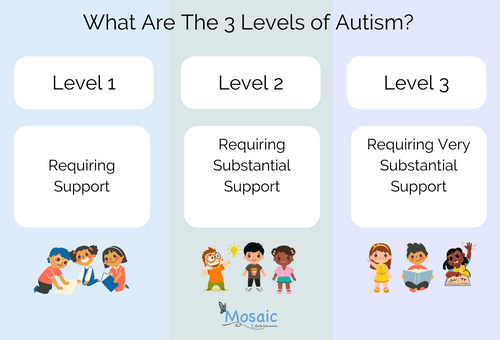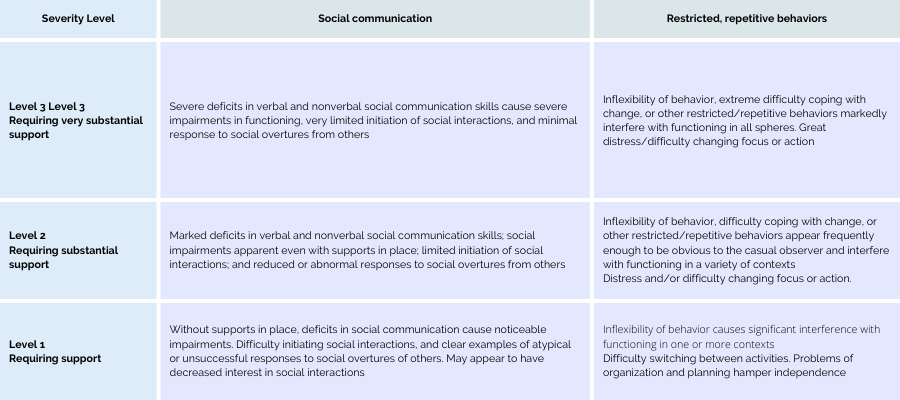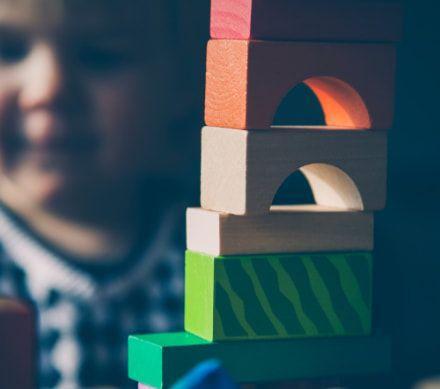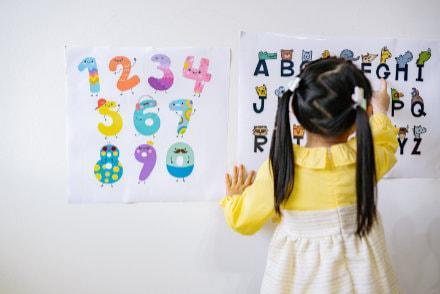Autism Spectrum Disorder (ASD) is diagnosed using the Autism Diagnostic Observation Schedule (ADOS). In Australia, this is typically administered by a psychologist or paediatrician.
If results indicate that there are deficits within the social communication area and the person presents with restricted and/or repetitive behaviours, then the person is likely to be diagnosed with ASD.

ASD is an umbrella term which takes into account many areas of a person’s functioning, social, communication, sensory, learning and other behaviours and people can fall anywhere within a broad spectrum.
Those on the end of the spectrum where they find these areas of functioning more complicated are given a diagnosis of ASD level 3 . Those on the other end of the spectrum will receive a diagnosis of ASD level 1, however, they will all fall under the umbrella of ASD .
The levels of ASD help parents, professionals and other people to understand how they can best support the child within their care.
The levels of ASD can also help clinicians and parents better understand the type of supports that their child may need to help them reach their goals.
According to the DSM-5, from the American Psychiatric Association, autism spectrum criteria include 3 classification (or severity) levels:
- Level 1: Requiring support
- Level 2: Requiring Substantial Support
- Level 3: Requiring Very Substantial Support

The classification levels are divided into two categories:
- Social Communication and
- Restricted and Repetitive Behaviors
‘The classification of ASD severity is based on the required levels of support to assist with impairments in social communication and social interaction, and restricted, repetitive patterns of behavior, interests, or activities’. [1]
A person can have a different classification level for each of the two elements of autism. For example, a child can be Level 1 in social communication but level 2 in restrictive, repetitive behaviors.
Severity levels can change overtime as children grow, learn and receive support. When a child’s barriers are reduced or removed, other areas of his or her life can be improved. The development of communication skills, for example, can reduce challenging behavior.
A person’s abilities to communicate, adapt to new situations, expand beyond restrictive interests, and manage daily life are assessed against the 3 levels of autism.
Severity levels for Autism Spectrum Disorder:
 Source: An Overview of Autism Spectrum Disorder, Heterogeneity and Treatment Options.
Source: An Overview of Autism Spectrum Disorder, Heterogeneity and Treatment Options.
Before delving into typical characteristics for children who fall within the different levels of ASD, it is important to note that all people with ASD are unique, just as each individual without ASD is.
The below descriptions are only some of the characteristics that we may see in people with ASD.
ASD Level 1
People who receive this diagnosis can vary greatly! ASD symptoms typically fall within this level.
Children with Level 1 autism will have some difficulty communicating and understanding social cues that can present in an infinite set of ways, from difficulty reading and noticing social cues, to expressive or receptive language difficulties, to confusion over facial expressions.
They will most likely also have limited interests or specific things that they are fascinated by which can also be noted as restricted or repetitive behaviours. However, support is there to help them to learn these skills and coping mechanisms to help them to achieve their full potential.
This may involve inability to understand body language, saying the wrong thing at the wrong time, experiencing back-and-forth communication difficulties and difficulty initiating conversation. As such, they may find friendships more complicated and confusing than neurotypical children.

In addition, it may be difficult for them to plan ahead or switch from one activity to another and they may not be as independent as their peers.
Some children may also have some delays in cognitive development, this includes the way they think, explore and problem solve in daily life. This can present as difficulty in the classroom environment, or possibly a lack of interest in certain activities or experiences and they may not get as involved as their peers. [2]
Restricted and/or repetitive behaviour may present as having fixated interests in literally anything that grabs their attention! From Marvel superheroes to ponies to train timetables whatever these children are interested in will likely become their very favourite topic of conversation!
This can sometimes make it more difficult for them to initiate and engage in play with their peers as finding common interests can be more difficult.
ASD Level 2
Children that fall within the Level 2 area often have more difficulty communicating. Using simple language to have their wants and needs met may be difficult and may take a lot of practice before their independence builds.
They likely will require support on a regular basis with a multidisciplinary team (e.g., Behaviour Analyst, Speech and Language Pathologist and Occupational Therapist).
When communicating, the person may engage in echolalia (for example, repeated use of phrases that they may have heard before, may seem meaningless), use only one-two word phrases or require an augmentative and alternative communication (AAC) system to communicate their wants and needs.
Restricted or repetitive behaviours are often more obvious, for example: they may engage in vocal scripting, repeated motor movements, or more severe fixations on non-functional objects in their environment.
They may have difficulty understanding and therefore coping with changes which can therefore be distressing and result in challenging behaviour.
ASD Level 3
Children that fall within the level 3 area for support are those who typically have severe difficulty expressing themselves both verbally and non-verbally.
They may not be able to speak or engage in conversation with others, and if they do initiate interaction, it may be solely to have their needs met.
Some children with ASD level 3 are completely non-vocal verbal (meaning they do not use spoken language) but may be able to communicate using an AAC device such as a speech generating device, pictures or signs.
Intensive supports are more often required to provide the person with everything they need to support them to achieve their full potential.

Children at this level typically require intensive daily support with a multidisciplinary team.
Restrictive and repetitive behaviours are often more intense and the person may spend the majority of their waking hours engaging in some form of repetitive behaviour.
Due to the challenges with communicating, challenging behaviour is often more severe and in some cases the person may engage in behaviours that can be harmful to themselves or the people around them (for example, aggression and self-injury).
With the appropriate support, particularly specialised behavioural support from a behaviour analyst, these behaviours can be reduced and managed so that potential harm to the person and others is greatly reduced.
Co-Occuring Conditions
It is not uncommon for children with ASD to experience other co-occurring conditions. This can include epilepsy or non epileptic seizures, trouble sleeping, anxiety, ADHD and gastrointestinal issues such as nausea and constipation. [2]
Early diagnosis and the appropriate management of these conditions can help to improve the child’s quality of life.

A case has been made that severity levels based on required levels of support may result in diagnosis inconsistencies. This is because there may be mixed levels of impairment across cognitive, adaptive and autism related symptoms.[1]
Assigning a level of autism can be helpful for determining the level of support that the child needs. However, it must be highlighted that each child is different and will require individualised support plans to suit their learning and development goals.
When children with ASD receive effective clinical support and guidance, their symptoms can be reduced, and so may their level of autism.
It is important to remember that all children with a diagnosis of ASD of any level receive that as a snapshot of what is going on for them at the period of time they are assessed, a formal diagnosis of ASD can be the start of gaining your child the support and intervention they need to grow and develop into the awesome person they will become.
Sources
- An Overview of Autism Spectrum Disorder, Heterogeneity and Treatment Options
- High-Functioning Autism
